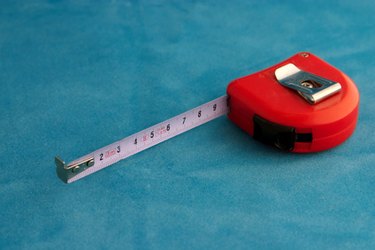
Measuring area is essential for many situations in the physical sciences, engineering, construction and more. To measure an area in a precise manner requires the use of appropriate measurement tools, which can be found in many homes and construction sites, as well as more complex tools used specifically for specialized functions.
Measuring Tape
Video of the Day
A measuring tape is possibly the simplest and most basic tool for measuring a standard area in inches, feet and centimeters. Essentially a flexible form of ruler made from a ribbon of plastic, fiber glass or metal with linear-measurement markings, you stretch it across the area to be measured. Measuring tapes typically have a hook at one end so that the operator can attach it to the area for a more accurate measurement. Several types of measuring tapes exist, including the standard pocket measuring tapes that are the most common and easiest to use and carry around; specialty measuring tapes for more accurate measurements, generally used by architects and estimators; fiberglass measuring tapes that stand up to typical wear and tear and are more sturdy and safe than conventional measuring tapes because they are protected from electrical hazards; and steel long tapes, offering greater accuracy in any kind of temperature, that are more sturdy than the fiberglass kind.
Video of the Day
Theodolite
A theodolite is an instrument for measuring both vertical and horizontal areas and angles in conjunction with triangulation. Triangulation, associated with geometry and trigonometry, is the process of establishing the location of a point by measuring angles to it from several other points on a fixed line. Through this process, you can establish the location as the third point of a triangle with one known side and two known angles. People typically use theodolites for engineering and surveying work, but they have other purposes in fields such as meteorology. The device consists of a telescope mounted on top of two perpendicular (horizontal and vertical) axes. If you point the telescope at an object, you can measure the angle of each of the axes. Modern theodolites can measure electronically and come with integrated electro-optical measuring devices that, through the use of polar coordinates, can transform to a pre-existing coordinate system in the area. Theodolites are useful in mapping, surveying and land assessment.
Planimeter
The planimeter, an instrument used to determine the area of a two-dimensional shape or planar region, is useful for measuring areas with irregular shapes and comes in several types: polar, linear and Prytz or "hatchet" planimeter. All planimeters work on the same premise, although with different constructions. They all have a linkage or series of closed chains with joints, allowing them to move with respect to each fixed link, and this linkage has a pointer at one end that is used to trace around the boundary of the shape. On a polar planimeter, the end of the linkage is fixed, while on a linear planimeter the end of the linkage is restricted to a line. When you trace the perimeter of an area, it induces a movement in another part of the planimeter that is used to read and establish the area of the particular shape. The planimeter also has a measuring wheel designed to roll around the drawing. When this wheel moves perpendicular to its axis, it measures and records the movement. When the wheel moves parallel to its axis, however, it does not record the movement; thus, the planimeter can measure the distance the wheel travels so you can determine the area through the number of times that the wheel rotates when the planimeter traces along the perimeter of the shape.